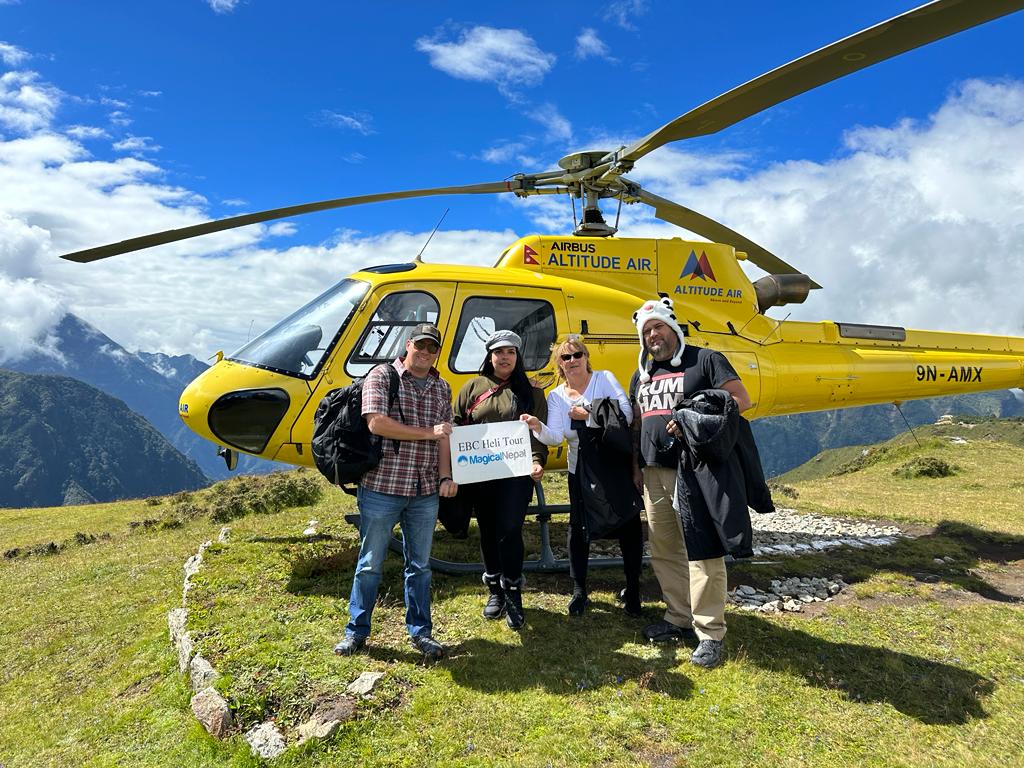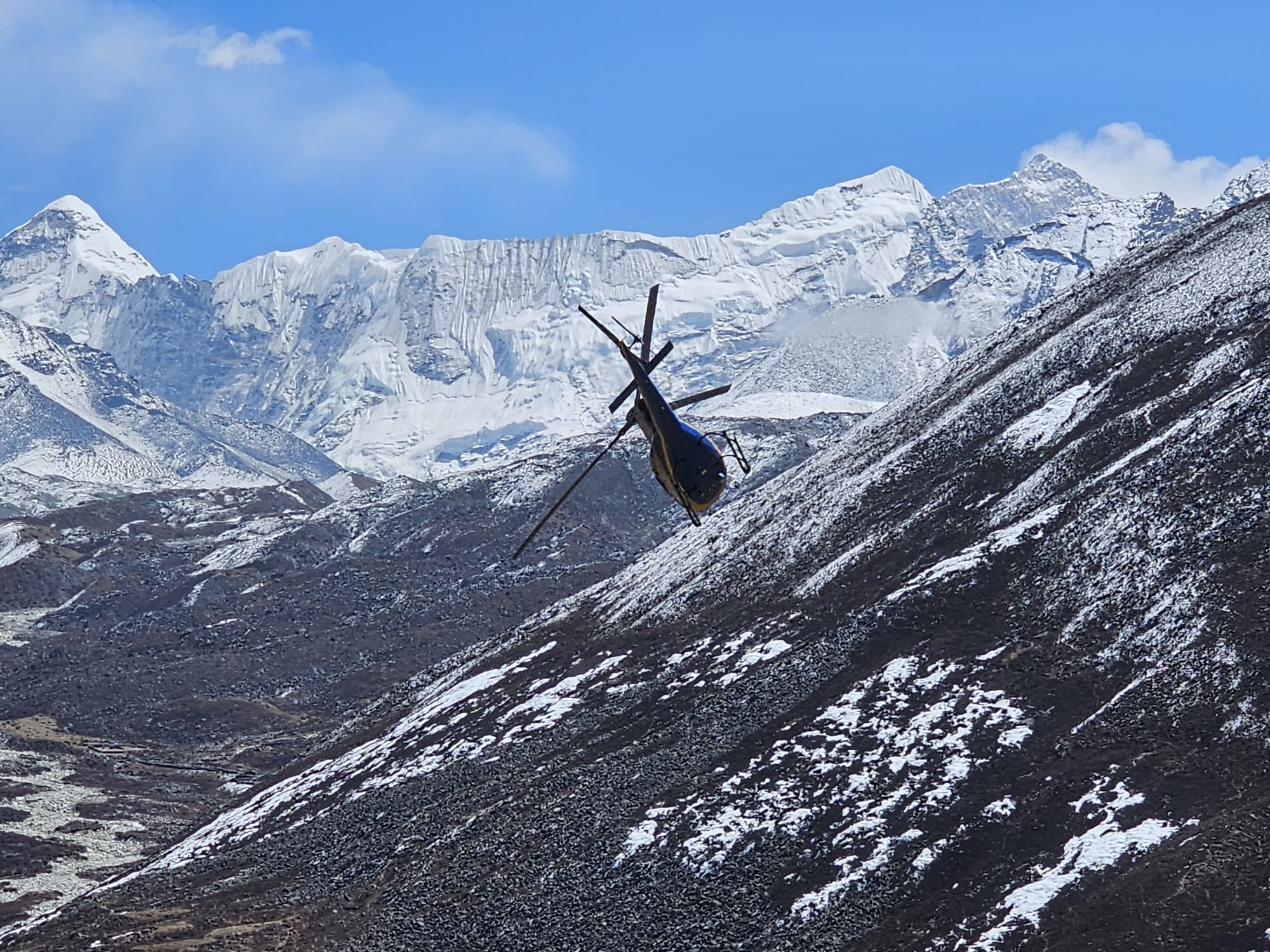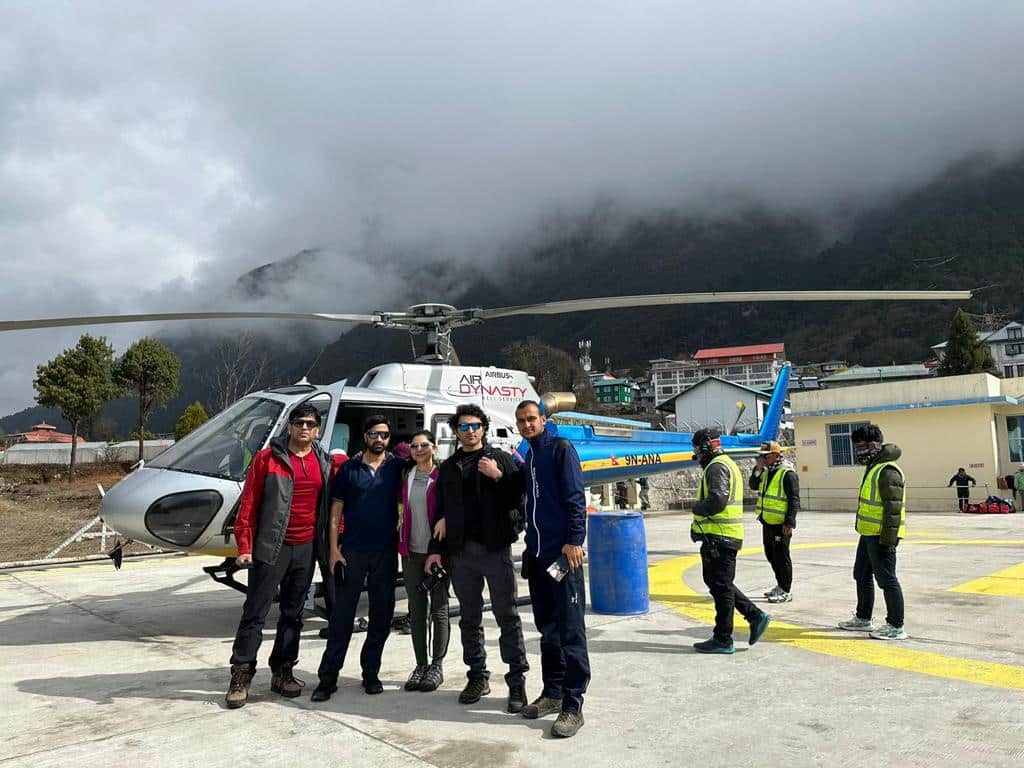With the latest civil aviation rule, we no longer offer this trip with the Kalapathar landing. This will be a flyover tour with a landing at Hotel Everest View only. We will only do a flyover around Kalapatthar and Everest Base Camp. A landing tour will cost you USD 2200 per person. Please WhatsApp/email us for the date and booking.
Everest Base Camp Helicopter Tour
| Tour Starting: Kathmandu | Tour End: Kathmandu |
| Tour Duration: 4 to 5 hours | Transport: Helicopter |
| Landing: Everest View Hotel | Tour Type: Helicopter Tour |
| Accommodation: Not Applicable | Meals: Not Included |
The Everest Base Camp Helicopter Tour is an exciting four-hour adventure that begins from the Tribhuvan International Airport, Kathmandu.
It provides you with a unique opportunity to experience the unmatched beauty of Everest and some of the Himalayas’ most famous mountains in the Everest Region from an exceptional viewpoint.
This guided tour, led by experienced helicopter pilots, ensures a memorable journey through stunning landscapes. It allows you to witness some of the Himalayas’ most majestic peaks firsthand, including Mt. Everest, Nuptse West Face, Lhotse, Khumbutse, Pumori, and Ama Dablam.
Forget a standard airplane flight! Our EBC Helicopter Tour is designed for adventure-seekers of all ages, with an unmatched level of safety and personalized experience.
Whether you are young or old, this ride is safe for you. You will be in good hands with our trained and experienced staff. The EBC Helicopter Tour may seem expensive compared to the fixed-wing Mount Everest Flight out of Kathmandu Airport.
You have two fantastic options for the Everest Base Camp Helicopter Tour! You can enjoy a private charter Everest base camp helicopter just for yourself by chartering the helicopter.
Alternatively, you can join a fixed departure date, where you’ll be part of a group of five people, including yourself. The choice is yours!
Everest Base Camp Helicopter Tour Highlights
- You will enjoy the adventurous Helicopter flight directly from Tribhuvan International Airport (Kathmandu) to the Everest Base Camp.
- Flying into the high-altitude Hilary Tenzing Airport at Lukla is an experience.
- Within four hours, you will fly in a Helicopter over the major places of the Everest Region and catch an aerial view of Lukla, Namche, Tengboche, and Everest Base Camp.
- You will reach the Everest Base Camp in a Helicopter with a comfortable Everest helicopter flight without sweat or lethargy.
- You will dine in the Everest View Hotel, one of the finest high-altitude hotels in the world!
- You will see the Khumbu glacier and stunning aerial views of the Himalayas, including Mount Everest (8,848m/29,029ft), Lhotse (8,516m/27,940ft), Choyu (8,201m/26,906ft), Nuptse (7861m/25791ft), Pumori (7161m/23494ft), and Ama Dablam (6,812m/22,349ft).
- No need to trek for days to reach Everest Base Camp. You can wave to the trekkers far below as you enjoy your aerial view of the Everest base camp in a helicopter.
Everest Base Camp Helicopter Tour Itinerary
Pickup from your Hotel to Tribhuvan International Airport, where you will meet other groups and our representative at the Domestic Terminal.
5:30 AM – 6:30 AM
Preparing for the departure. Our representative manage all the necessary documents and take you to the helicopter for the departure.
6:00 AM – 6:30 AM
Get ready for an incredible journey as your helicopter takes off from Tribhuvan International Airport in Kathmandu. Heading east, you’ll fly alongside the majestic Himalayan mountain range towards the famous Hilary Tenzing Airport in Lukla, nestled in the Everest Region. Enjoy stunning views of the mountains and valleys below as you embark on this unforgettable adventure in the sky.
6:30 AM – 7:15 AM
Stop at Lukla for refueling or at Everest View Hotel for Breakfast Your journey will include a stop either in Lukla or Syanboche. If the helicopter requires refueling, you’ll touch down in Lukla. However, if refueling isn’t necessary, you’ll land in Syanboche at the Everest View Hotel for a delightful breakfast amidst the stunning Himalayan scenery.
7:15 AM – 8:30 AM
Everest View Hotel to Lukla with a flyover to Everest Base Camp
8:30 AM – 10:00 AM
There is a possibility of making a stop in Lukla for refueling during the return journey to Kathmandu if the helicopter wasn’t refueled at the beginning of the tour. This ensures a smooth and uninterrupted flight back, allowing you to relax and enjoy the breathtaking views one last time before concluding your Everest Base Camp Helicopter Tour.
10:00 AM – 11:00 PM
After completing your Everest Base Camp Helicopter Tour, you’ll be driven from Tribhuvan Domestic Airport to your hotel in Kathmandu. Note: The timing can change depending on weather and availability
11:00 AM – 12:00 PM
Not satisfied with this Everest Helicopter Tour Itinerary?
Are you interested on planning custom trip? It only takes 2 minutes.
Booking and Confirmation
If you’re interested in booking a helicopter tour to Mount Everest with Magical Nepal, here’s how you can do it:
- Choose your desired tour date from the available options. If you are booking a Private helicopter tour please book it through the private Departure section
- Please ask us before booking if you want to land it at Kalapathar.
- Fill out the necessary information on the booking form, including your name, contact details, and any special requests.
- Once you’ve completed the booking form, your reservation will be confirmed.
- If you need to cancel your booking, you can do so up to 24 hours(Local time) before the departure date without incurring any fees, except for bank fees.
- After booking, check your email for any confirmation or additional information from Magical Nepal.
- Prepare for your tour by reviewing any guidelines or instructions provided by MagicalNepal and ensuring you have all the necessary documents and preparations in place.
Enjoy your helicopter tour to Mount Everest with Magical Nepal!
Includes for Everest Base Camp Helicopter Tour
- Hotel Airport Hotel Private Car Transfer
- Helicopter Kathmandu Lukla Kalapatthar Hotel Everest View Kathmandu
- Airport tax (NPR 500 each)
- Khumbu Pasang Lhamu Municipality Permit (2000)
- Sagarmatha National Park Entry Permit (NPR 3000)
- Breakfast at Everest View Hotel (USD 20-25)
Everest Base Camp Helicopter Tour FAQs
Booking Process
How can I book this tour? How much do I have to pay in advance?
You can reserve this tour by using our booking system. Simply select your desired date, and proceed with the booking process. Our system will gather all the necessary information from you.
Is there a chance of cancellation of this tour?
In the event of adverse weather conditions, there is a possibility of tour cancellation. However, we offer a full refund or the option to reschedule the date in such circumstances.
What is the cancellation Policy?
You have the option to cancel the helicopter tour up to 24 hours before the scheduled departure time (Nepal time). Cancellations can be made through our booking portal or by emailing us directly.
A full refund will be issued to your bank account. Please note that while we will process the refund immediately, it may take 8 to 10 days for the funds to appear in your account due to banking procedures.
How can I book the Private tour?
You can easily book a private tour by selecting the “Private Tour” option in our booking section. Simply click on the designated button and proceed to provide the necessary information for your private tour.
What happens to the tour If the weather is bad?
If the weather conditions are unfavorable, your tour will be rescheduled to the next day.
Weather and Safety
How cold does it get on this tour? What kind of gear do I need?
When preparing for the cold during the shuttle flight to Everest Base Camp, we recommend bringing a down jacket or any other warm jacket to keep yourself insulated. Additionally, there are guesthouses available in Pheriche where you can take shelter from the cold. Staying indoors will provide relief from the chilly temperatures outside.
What does shuttle work in Everest Helicopter Tour?
Our journey begins with a scenic flight from Kathmandu to Lukla, where we might make a quick stop for refueling.
Afterward, we’ll fly you to the stunning Everest View Hotel in Sanboche, where you’ll enjoy a delicious breakfast with breathtaking views of the majestic peaks.
From Sanboche, we’ll continue to Pheriche, where a short shuttle flight will take you to the iconic Everest Base Camp.
Due to altitude limitations, the shuttle flight ensures everyone gets to experience the awe-inspiring panorama from a window seat – a memory you’ll never forget.
How safe is the Everest Base Camp Helicopter tour?
We operate multiple helicopters during the Everest Base Camp trek, adhering to strict safety procedures to ensure your trip is secure. EBC Heli Tour is very safe
Do you fly when the weather is bad?
We don’t fly the helicopter when the weather is bad. We will change it to the next day or cancel the tour if the weather is bad.
Time
I have to catch an international flight on the same day. Is it possible to do this tour?
Yes, it is indeed possible to catch your international flight on the same day as the tour. The tour typically concludes between 11 to 12, allowing you to return to Kathmandu by 1 PM, giving you ample time to catch your international flight.
Can the timing change? Is there a chance a tour will get longer?
The timing of the tour may vary depending on weather conditions or the helicopter flight schedule. Occasionally, the trip may be extended due to these factors.
Where is Kathmandu Domestic Airport?
Kathmandu Domestic Airport is located adjacent to Kathmandu International Airport. After your helicopter flight, you can conveniently walk to Kathmandu International Airport, as it’s just a 5-minute walk away.
Cost
What is the cost of the Everest Base Camp Helicopter Tour?
The cost for the Everest Base Camp Helicopter Tour is USD 1350 per person. If you choose to charter the helicopter exclusively for your group, the cost is USD 5500.
What is the difference between a private trip and a Group Departure?
In a private trip for the Everest Base Camp Helicopter Tour, you’ll have the entire helicopter to yourself or your family, offering a personalized and flexible experience.
This option ensures exclusivity but comes at a higher cost. Alternatively, with a group departure, you’ll share the helicopter with other passengers from the same departure group, making it a more affordable option, especially for solo travelers or smaller groups.
Both options provide a memorable journey to Everest Base Camp, catering to different preferences and budgets.
Will the cost remain the same if the number of people doesn’t reach 5 in a group departure?
Yes, the cost remains the same even if the number of people doesn’t reach the maximum capacity of 5 in a group departure. The pricing structure is fixed and does not depend on the number of passengers who occupy the helicopter. Therefore, whether there are fewer than 5 passengers or the maximum capacity is reached, the cost remains unchanged.
Is there a different price for children below 5?
No, there is no price difference for children below 5 years old. The cost of the helicopter tour remains the same regardless of age, as each seat in the helicopter has a fixed price. Therefore, children below 5 years old occupy one of the five seats available in the helicopter.
Are there any hidden charges?
No, there are no hidden charges.
Can I pay the permits, Breakfast, and Airport tax to you?
No, you have to pay it as you go. Thus, it doesn’t make sense to pay it to us. We can’t pay for these services from Kathmandu except for breakfast.
Helicopter
Can we see Everest From Helicopter?
Yes, you can see Mount Everest from the helicopter during the Everest Base Camp Helicopter Tour. The tour is designed to provide passengers with breathtaking aerial views of Mount Everest and the surrounding Himalayan landscape. While visibility may vary depending on weather conditions, the helicopter flight typically offers excellent opportunities to see the world’s highest peak and other iconic mountains in the region.
Do we stop at Everest Base Camp?
The helicopter typically does not make a landing at the actual Everest Base Camp. Instead, the tour provides an aerial view of the base camp from the helicopter, allowing passengers to admire the stunning scenery from above.
Is it possible to land in Kalapathar?
No, it is not currently possible to land in Kalapathar during the Everest Base Camp Helicopter Tour. Recent regulations prohibit helicopters from landing in Kalapathar. Therefore, the tour typically focuses on providing aerial views of the region, including Kalapathar, without making a landing at that specific location.
Can we fly over Everest on the tour
Yes, you will fly over Everest in the EBC Heli Tour
Is there any guide for this tour? Who will lead us to the tour?
During the Everest Base Camp Helicopter Tour, the pilot will serve as your guide and lead you on the tour. The pilot is highly experienced and knowledgeable about the region, providing informative commentary throughout the flight and ensuring a safe and enjoyable experience for all passengers.
What do you do in case of altitude sickness? Are there oxygen supplies in the helicopter
In case of altitude sickness during the Everest Base Camp Helicopter Tour, oxygen supplies are available in the helicopter for emergency use.
The pilot and crew are trained to recognize symptoms of altitude sickness and can assist as needed.
If passengers experience severe symptoms, such as difficulty breathing or dizziness, the pilot will take necessary measures to address the situation, including providing supplemental oxygen and potentially descending to lower altitudes. Additionally, passengers need to stay hydrated, avoid alcohol and heavy meals, and inform the pilot or crew if they start to feel unwell due to altitude.
Why it is called an EBC helicopter tour when we don’t even land at Everest Base Camp
While helicopters don’t land directly at Everest Base Camp, they get incredibly close.
Everest Base Camp is located on the shifting Khumbu Glacier, making it an unstable landing spot for helicopters. There are also concerns about noise pollution and potential disturbance to climbers during their expedition season.
What happens When I am in the middle seat of a helicopter? How can I enjoy the tour without a window seat?
There are multiple stops during the tour, everyone will have the opportunity to experience the beauty of Everest from a window seat at some point during the journey.
The pilot and crew typically arrange seating rotations or adjustments at each stop to ensure that all passengers have a chance to enjoy the scenic views from a window seat.
Can I book a Window seat in Advance?
In a group tour, seating arrangements are typically assigned by the crew members, and it is not possible to book a window seat in advance.
However, since there are multiple stops during the tour, everyone will have the opportunity to experience the beauty of Everest from a window seat at some point during the journey.
Why Should you Consider a Helicopter ride to see Everest?
You can reach Everest Base Camp in 4 hours: Trekking to Everest Base Camp typically takes 12 days, while a helicopter ride can offer a glimpse of Everest in just a four hours. If you have limited time constraints, a helicopter ride is an efficient way to experience the Everest Base Camp without committing to a lengthy trek.
Convenience: Helicopter tours provide a more convenient way to see Everest Base Camp without the physical exertion and challenges of trekking. You won’t need to carry heavy backpacks or endure long hours of walking, making it a more comfortable option, especially for travelers who prefer a less physically demanding experience.
Personalized Experience: Helicopter tours can be tailored to meet your specific preferences and interests. Whether you want a scenic flight around Everest or a landing at Everest Base Camp for a closer view of the mountain, you have the flexibility to customize your experience according to your preferences.
Equipment for Everest Base Camp Helicopter Tour
Clothing:
- Comfortable, weather-appropriate clothing (layers are recommended as temperatures can vary)
- Light jacket or sweater (even if it’s warm at lower altitudes, it can get cooler as you ascend)
Accessories:
- Sunglasses with UV protection
- Hat or cap to shield from the sun
Footwear:
- Comfortable shoes suitable for walking short distances (hiking boots are not necessary)
Personal Items:
- Sunscreen
- Lip balm with SPF
- Camera or smartphone for capturing breathtaking views
- Personal medications (if any)
- Cash (small bills for Breakfast, airport tax, etc.)
Weather during the Everest Base Camp Tour
If you’re planning a helicopter tour to Everest Base Camp, it’s essential to prepare for the unique weather conditions you may encounter. Here’s a guide on how to prepare:
Nepal has four weather. Spring Autumn, Monsoon, and Winter. Spring and autumn are the most popular seasons for people visiting Nepal. These seasons offer favorable weather conditions, making them ideal for various outdoor activities such as trekking, mountaineering, sightseeing, and wildlife viewing.
Weather at Kathmandu Domestic Airport
- Kathmandu is situated at an elevation of 4,344 feet (1,324 meters). During March and April, expect mostly warm weather throughout the day at Kathmandu Airport. You can wear a T-shirt and board the helicopter comfortably.
- In winter (December to early March), Kathmandu experiences colder temperatures. While it doesn’t snow in Kathmandu, make sure to wear layers to stay warm, especially in the mornings.
Clothing Recommendation at Kathmandu Airport:
- A T-shirt is suitable for boarding for your helicopter tour in March and April. However, carrying a down jacket for the tour is recommended, as temperatures may vary in the Everest region. During the monsoon season (June to early September), carrying an umbrella or rain jacket is advisable due to the possibility of rain.
- In winter, wearing layers is advised, especially in Kathmandu. Although there’s no snow in Kathmandu during this time, there may be snow on the trail to Lukla, so prepare accordingly. Please refer to our Equipment Checklist section
Weather in Lukla (Stop 10 to 30 minutes for refueling).
Climate and Temperature in Lukla:
- Lukla is generally cold, especially during the winter months, with temperatures potentially dropping below 0 degrees Celsius (32 degrees Fahrenheit), particularly at night.
- During the favorable seasons like Spring and Autumn, Lukla experiences milder daytime temperatures ranging from approximately 10 to 20 degrees Celsius (50 to 68 degrees Fahrenheit).
Clothing Requirements:
- When you reach Lukla, your down jacket will be essential to keep you warm, especially during colder weather.
- Dressing in layers, including thermal wear, fleece jackets, and waterproof outer layers, is recommended to stay comfortable and adjust to changing temperatures.
Weather in Everest View Hotel (Stop for 30 to 45 minutes at Each Location) and Pheriche
- Spring, Autumn, and Summer: During these seasons, the temperature ranges from around 2 to 10 degrees Celsius (35 to 50 degrees Fahrenheit). Dressing in layers is advisable to stay comfortable as temperatures may vary throughout the day.
- Winter: In winter, temperatures can drop to around 0 to -5 degrees Celsius (32 to 23 degrees Fahrenheit). Be sure to bundle up with warm clothing, including thermal wear, fleece jackets, and a heavy down jacket to stay warm during your tour.
Helicopter Tour to Everest Base Camp Route Map
Other Available Helicopter Tours in Everest
The Everest region offers diverse helicopter tours, providing breathtaking aerial experiences. For those who enjoy adventure on the ground, you can combine hiking with a thrilling helicopter flight. Here are some of the most popular helicopter tours in Everest:
Kathmandu to Luka Helicopter Flight
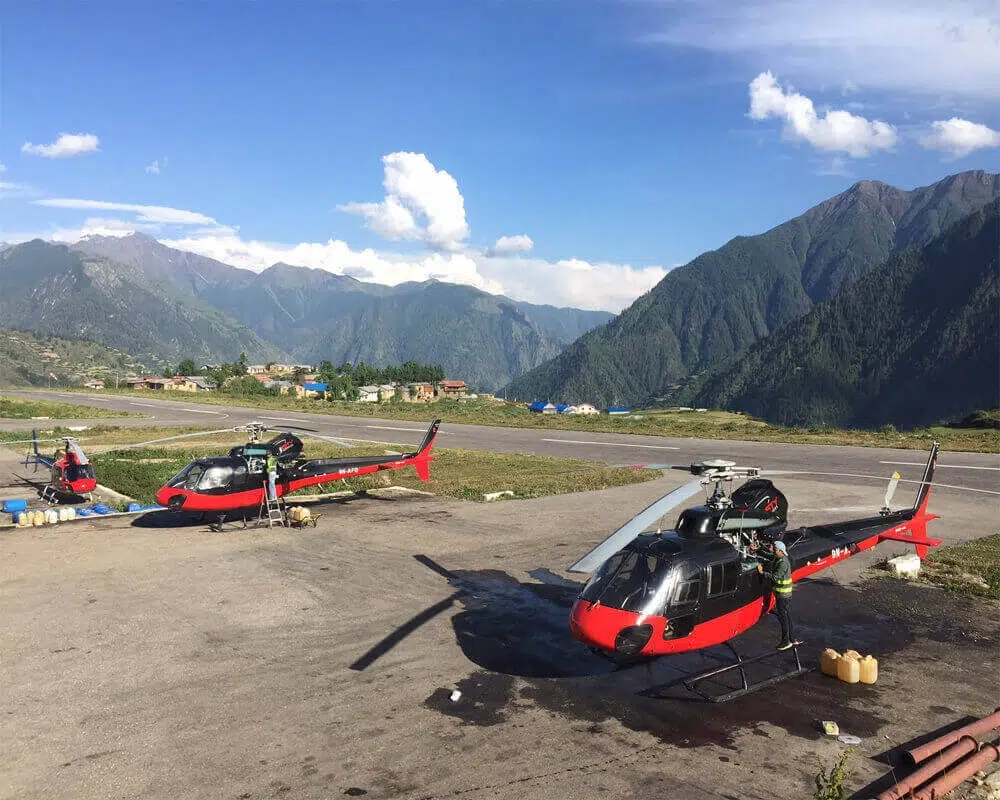
Opting for the Kathmandu to Lukla helicopter flight offers a convenient and efficient way to reach the Everest gateway, particularly in unpredictable weather conditions.
Unlike fixed-wing planes, helicopters provide greater flexibility to navigate challenging weather, ensuring a smoother and more reliable journey.
With the option to depart directly from Kathmandu Airport, you can avoid traveling to Ramechhap Airport, saving you both time and inconvenience.
This makes the helicopter flight a popular choice for travelers like you seeking a seamless travel experience to the Everest region.
Kathmandu to Namche Helicopter Flight
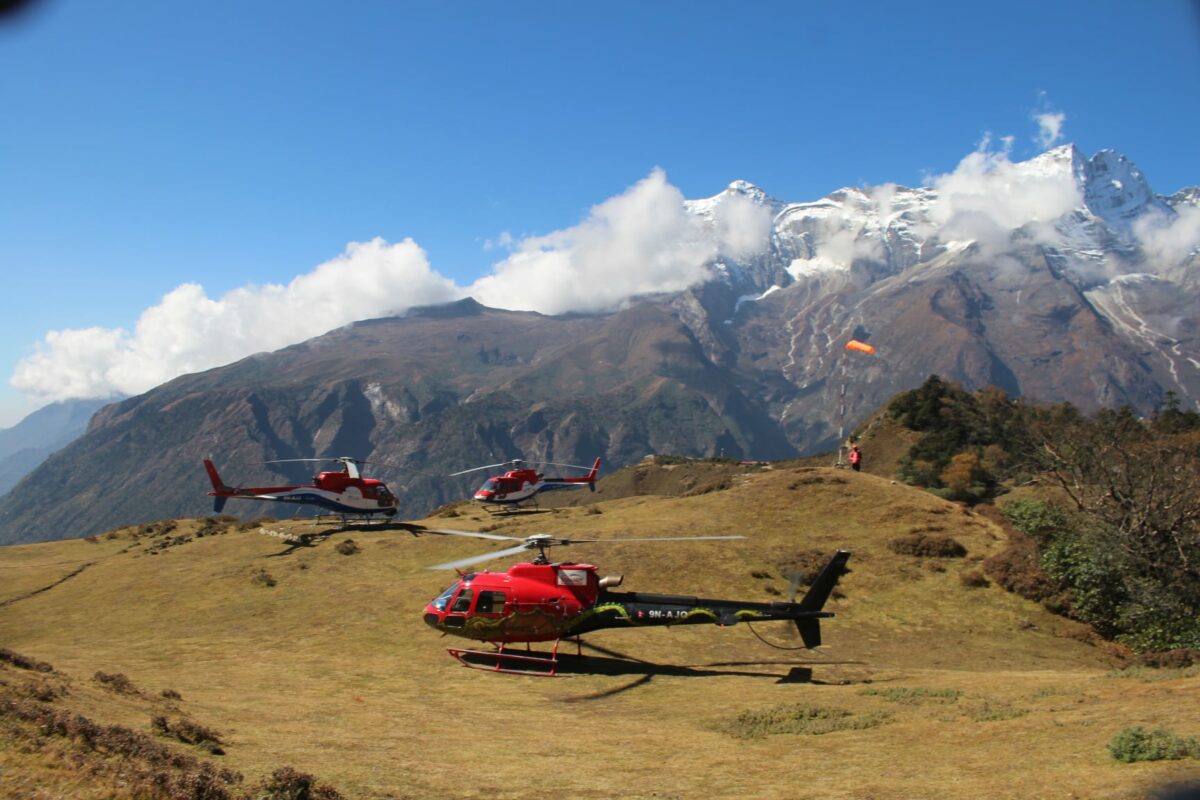
Namche Bazaar, nestled in the heart of the Everest region, is a bustling mountain town renowned as the gateway to the Everest Base Camp trek.
Perched at an altitude of approximately 3,440 meters (11,286 feet), Namche offers stunning panoramic views of the surrounding Himalayan peaks, including Mount Everest.
The town boasts a vibrant atmosphere with traditional Sherpa culture, colorful markets, cozy teahouses, and trekking amenities, making it a popular acclimatization stop for trekkers.
A helicopter tour is a great option for those wishing to experience Namche Bazaar’s charm without embarking on a trek. It offers a convenient and scenic way to visit this picturesque town in the Himalayas.
Gorakshep to Kathmandu Helicopter Flight
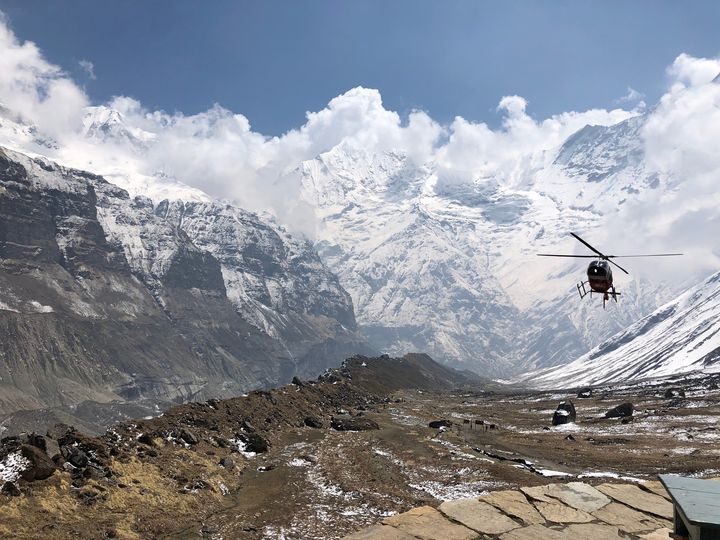
The Gorakshep to Kathmandu helicopter flight offers a swift and scenic journey back to Kathmandu after completing the Everest Base Camp trek or exploring the surrounding Himalayan region.
Opting for the helicopter is an excellent choice, especially for those seeking to complete the Everest Base Camp Trek in a shorter period.
This option allows you to enjoy the breathtaking views of the Himalayas from the comfort of a helicopter, providing a memorable and efficient way to conclude your trekking adventure.
During the flight, you’ll stop in Lukla to refuel before continuing on to Kathmandu, where your journey ends.
Whether you’re pressed for time or prefer the convenience of air travel, the helicopter flight from Gorakshep to Kathmandu offers an unforgettable experience that combines the thrill of flight with the stunning beauty of the Himalayan landscape.
Kathmandu to Everest View Hotel Helicopter
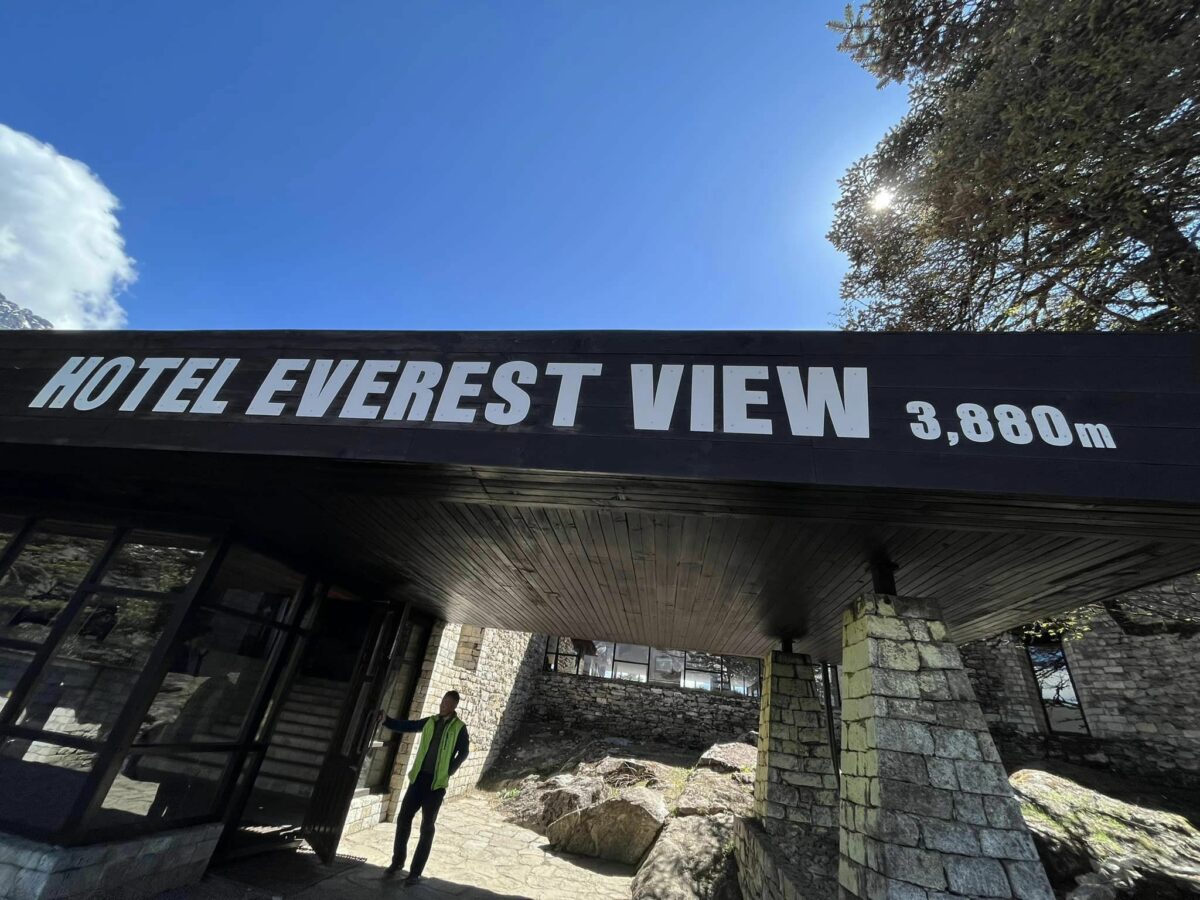
If you dream of savoring breakfast at the highest altitude while soaking in breathtaking views of Everest and other iconic peaks, but the thought of trekking for hours seems daunting, look no further.
The Everest Base Camp helicopter to Everest View Hotel in Syanboche offers the perfect solution.
This trip is tailor-made for those who crave the comfort of a scenic helicopter ride and the awe-inspiring experience of witnessing Everest up close, all while enjoying a delicious breakfast amidst the stunning Himalayan landscape.
It’s the ultimate way to fulfill your Everest dreams without the strenuous trekking hours.
Kathmandu to Gokyo Lake Helicopter
The Kathmandu to Gokyo Lake helicopter tour is a great choice for travelers who want to experience the beauty of Gokyo Lake without the physical exertion of trekking.
This aerial journey offers stunning views of the Himalayan landscape, making it an ideal option for those seeking a memorable adventure in Nepal.
For travelers seeking to explore both iconic destinations in the Everest region, the Kathmandu to Gokyo Lake helicopter tour can be seamlessly combined with an Everest Base Camp tour.
Best Time for Everest Base Camp Helicopter Tour
The optimal seasons for embarking on an Everest Base Camp Helicopter Tour are March to May (Spring), September to November (Autumn), and December to February (Winter).
These periods offer distinct advantages and favorable weather conditions for an unforgettable aerial adventure amidst the breathtaking Himalayan landscape.
Let’s delve into the best times to undertake this awe-inspiring journey.
March to May (Spring):
Springtime, spanning from March to May, is the peak expedition season in Everest. During this period, helicopters primarily transport expedition supplies and rescue missions for sick patients.
The weather is typically favorable, with the clear blue skies and excellent visibility of the mountain peaks.
However, it’s essential to note that the demand for helicopter tours may surge during this season, leading to potential fluctuations in tour prices due to supply and demand dynamics.
Visibility: Generally excellent visibility with clear blue skies, providing panoramic views of the Himalayan peaks and surrounding landscapes.
Crowd: Due to the peak expedition season, moderate to high activity levels exist. There has been increased helicopter traffic for transporting expedition supplies and conducting rescue missions.
- Temperature: Mild to moderate temperatures during the day, but can be chilly at higher altitudes.
- View: Vibrant and colorful landscapes with blooming rhododendrons and other flora. Clear views of the snow-capped peaks against the backdrop of clear skies.
June to Early September (Monsoon Season):
June to early September marks Nepal’s monsoon season, bringing unpredictable weather patterns and heavy rainfall.
Cloud cover may obstruct visibility, potentially limiting panoramic views of the Himalayas. While bookings are accepted during this period, it’s crucial to acknowledge the inherent weather-related challenges.
However, rest assured that in the event of flight cancellations due to inclement weather, refunds are promptly processed, or alternative tour dates can be arranged.
- Visibility: Visibility is generally poor due to heavy rainfall and cloud cover. Clouds may obstruct views of the mountain peaks and surrounding landscapes, limiting visibility during helicopter tours.
- Crowd: Due to the monsoon season, low to moderate activity levels exist. Fewer tourists and trekking groups than during peak seasons result in fewer helicopter tour bookings.
- Temperature: Mild to moderate temperatures during the day, but high humidity levels. Rainfall and occasional thunderstorms may lead to challenging flying conditions.
- View: The Himalayan peaks and surrounding landscapes offer limited views due to cloud cover and rainfall. The lush greenery of the landscape during the monsoon season offers a different perspective, but overall visibility may be compromised.
September to November (Autumn):
Widely regarded as the best season for trekking in Nepal, September to November offers unparalleled opportunities for an Everest Base Camp Helicopter Tour.
With clear blue skies and crisp mountain air, this period provides optimal conditions for a memorable aerial adventure.
Whether you’re seeking panoramic views of snow-capped peaks or breathtaking vistas of the surrounding landscapes, autumn presents an ideal window for an unforgettable helicopter tour experience.
- Visibility: Excellent visibility with clear skies, offering uninterrupted views of the mountain peaks and surrounding terrain.
- Crowd: Moderate levels of activity. It’s a popular trekking season, but helicopter tours may have relatively fewer bookings than trekking groups.
- Temperature: Mild temperatures during the day with cool evenings. Comfortable conditions for flying and exploring.
- View Crisp and clear views of the Himalayan peaks against clear autumn skies. Spectacular colors as the foliage changes, especially in late autumn.
Winter (December to February):
From December to February, winter presents a unique but equally captivating opportunity for an Everest Base Camp Helicopter Tour. While this season may not be as popular as spring or autumn, it offers its own set of advantages for adventurous travelers.
Clearer skies and reduced cloud cover during winter can enhance visibility, offering uninterrupted views of the towering peaks and rugged terrain below.
The crisp winter air also lends remarkable clarity to the landscape, further enhancing its beauty.
With proper preparation and suitable clothing, a winter helicopter tour to Everest Base Camp can be an unforgettable experience, providing a unique opportunity to witness the Himalayas in all their wintry splendor.
- Visibility: Generally good visibility with clear skies, although occasional snowfall may limit visibility temporarily.
- Crowd: There are low to moderate levels of activity. There are fewer tourists than during peak seasons, offering a quieter and more intimate experience.
- Temperature: Cold temperatures, especially at higher altitudes. Proper clothing and gear are essential for staying warm.
- View: Stunning snow-covered landscapes create a serene and picturesque setting. The snow-capped peaks stand against the clear winter skies, offering a magical and tranquil atmosphere.
In conclusion, while each season offers unique advantages and considerations for an Everest Base Camp Helicopter Tour, the months of March to May and September to November stand out as the prime periods for this thrilling adventure.
At Magical Nepal, we understand that choosing between the Everest Base Camp trek and a helicopter tour is a significant decision. Our goal is to provide you with the insights to make the most informed choice for your unique travel aspirations. Here are some key factors to ponder:
Why consider Everest base Camp Helicopter Tour
At Magical Nepal, we understand that choosing between the Everest Base Camp trek and a helicopter tour is a significant decision.
Our goal is to provide you with the insights to make the most informed choice for your unique travel aspirations. Here are some key factors to look at
Budget: Reaching Everest’s Footsteps
Helicopter tours offer a luxurious and time-efficient way to experience Everest, but they are more expensive than the traditional trek.
If your budget allows and you prioritize a swift and visually spectacular adventure, a helicopter tour can be an excellent investment. For those seeking a more cost-effective approach, our expertly guided treks offer a fulfilling and immersive alternative.
Adventure Preferences: Your Style, Your Journey
Do you yearn for the physical challenge and cultural connections the multi-day trek offers? It allows you to walk the same paths as legendary mountaineers while interacting with welcoming Sherpa villages along the way.
If your primary focus is on witnessing Everest’s breathtaking grandeur with unparalleled aerial views, the helicopter tour delivers this experience in a condensed and exhilarating fashion.
Health Considerations: Adventure for All
While the helicopter tour minimizes strenuous exertion, altitude sickness remains important to consider. Consult your doctor, especially if you have pre-existing conditions, to determine which option is safest.
We prioritize your health at Magical Nepal, offering personalized advice and ensuring you have the necessary information.
The Time Factor: A helicopter tour is the most efficient way to reach Everest Base camp
When time is of the essence, an Everest helicopter tour empowers you to witness Everest’s magic even with limited vacation days.
Our treks, with varying duration options, also provide fantastic ways to fit within your travel schedule.
Everest Base Camp Trek Vs Everest Base Camp Helicopter Tour
Here’s a breakdown of the key differences between the Everest Base Camp Trek and the Everest Base Camp Helicopter Tour:
The experience between EBC Trek and Everest Helicopter Tour:
Everest Base Camp Trek:
Setting out on the Everest Base Camp Trek entails an immersive journey through the heart of the Himalayas. Trekking over several days, adventurers traverse diverse landscapes, from verdant forests to rugged terrains, experiencing the awe-inspiring peaks and valleys up close.
Along the way, encounters with Sherpa villages offer glimpses into local culture, fostering a deep connection to the region’s heritage.
The Everest Base Camp Trek is a challenging yet immensely rewarding endeavor, culminating in the breathtaking sight of Everest Base Camp. Upon reaching Everest Base Camp, the sense of accomplishment is unparalleled, leaving you with indelible memories of their Khumbu odyssey.
Everest Base Camp Helicopter tour
Conversely, the Everest Base Camp Helicopter Tour offers a thrilling and expedited adventure for those seeking a unique aerial perspective. From the moment the helicopter ascends from kathmandu, you are treated to panoramic vistas of the Khumbu Valley and its surrounding peaks, including the majestic Everest.
This aerial excursion provides an unparalleled opportunity to marvel at the grandeur of the Himalayas from above, offering a perspective rarely seen.
As the helicopter Everest base camp helicopter tour glides over the landscape, passengers are awestruck by the sheer scale and beauty of the terrain below. The pinnacle of the tour is a lavish breakfast at the Everest View Hotel, where guests indulge in delectable cuisine amidst breathtaking vistas of the world’s highest mountains.
Conclusion
Ultimately, choosing between the Everest Base Camp Trek and the Everest Base Camp Helicopter Tour hinges on individual preferences and priorities.
For those seeking an immersive and physically demanding experience, the EBC trek offers a deeply fulfilling journey marked by cultural encounters and natural wonders.
In contrast, the EBC helicopter tour provides a convenient and exhilarating option for those with time constraints or a desire for a different perspective of the Himalayas.
Whether trekking through the Everest base camp or soaring above them, both experiences promise unforgettable memories and a profound appreciation for the majestic beauty of Nepal’s Everest region.
Time Commitment:
The Everest Base Camp Trek demands a significant time commitment, typically spanning 14 days with 2 acclimatization days. This multi-day adventure is designed for you to acclimatize gradually to the high altitude while immersing yourself in the stunning landscape of the Himalayas.
The extended duration of the trek enables participants to experience the changing scenery, interact with local communities, and savor the journey’s challenges and triumphs, ultimately fostering a deeper connection to the region.
In contrast, the Everest Base Camp Helicopter Tour offers a convenient option for those with limited time. This day trip from Kathmandu lasts approximately 4 to 5 hours, providing a condensed yet exhilarating experience of witnessing the awe-inspiring sight of Everest and its surroundings.
Despite its shorter duration, the EBC helicopter tour still delivers breathtaking aerial views and the opportunity to enjoy a luxurious breakfast amidst the Himalayan panorama, making it an ideal choice for travelers seeking a quick but memorable encounter with the world’s highest peak.
Physical Exertion:
Embarking on the Everest Base Camp Trek will take you through a series of physically demanding challenges, including uphill climbs and traversing rocky paths.
As you go through the Khumbu region of Nepal, you’ll encounter steep ascents and descents, particularly in areas such as Namche Bazaar, Tengboche, and Lobuche. The trail winds its way through rugged terrain, with sections of narrow ridges and rocky steps that require careful navigation.
You’ll ascend and descend thousands of feet in elevation each day, testing both your endurance and your footing. Along the route, you’ll also navigate through glacier moraines and cross suspension bridges spanning deep Himalayan gorges, adding to the adventure and excitement of the trek.
These challenging sections of the trail demand concentration, stamina, and a steady pace as you journey toward the ultimate goal of reaching Everest Base Camp.
Everest Base Camp Helicopter Tour offers a more leisurely experience with minimal physical exertion required from your end.
During the tour, you’ll soar above the Himalayas and enjoy breathtaking views without needing strenuous activity. Brief landings at designated spots will allow you to disembark and take in the scenery up close, but you won’t face any challenging hikes or steep climbs.
This makes the helicopter tour an accessible option for individuals of varying fitness levels or those with mobility restrictions, providing a comfortable and convenient way to witness the splendor of Everest and its surroundings.
Cost:
Regarding cost, trekking to Everest Base Camp typically proves to be a more budget-friendly option than an Everest helicopter tour’s premium experience. The expenses associated with trekking include permits, accommodation along the route, meals, guide fees, and the optional cost of hiring porters to assist with carrying gear.
While these costs can vary depending on the specific itinerary and level of comfort desired, trekking generally offers a more economical way to experience the Everest region for those with a tighter budget.
In contrast, the Everest Base Camp Helicopter Tour is a premium experience that comes with a significantly higher price tag. This all-inclusive package covers the cost of the helicopter flight itself, multiple landings at designated spots including Everest Base Camp, a luxurious breakfast at the Everest View Hotel, and airport transfers.
While the helicopter tour provides a more expedited and luxurious way to witness the breathtaking vistas of the Himalayas, it is important to consider the higher cost associated with this option for those seeking a more exclusive and convenient adventure.
Accessibility:
Everest Base Camp Trek demands physical readiness and careful acclimatization, making it achievable with proper training and preparation. However, it’s essential to acknowledge that the high altitude and physical exertion involved may render the trek unsuitable for everyone.
While many adventurers successfully complete the trek, factors such as individual fitness levels and susceptibility to altitude sickness must be considered. It’s crucial to undertake adequate training beforehand and consult with healthcare professionals to assess suitability for the journey.
The Everest Base Camp Helicopter Tour offers a more accessible alternative, particularly for those with time constraints, physical limitations, or concerns about altitude sickness.
This option provides a convenient and expedited way to witness the splendor of Everest without the need for strenuous hiking or extended periods at high altitudes. However, it’s important to note that age and weight restrictions may apply, as helicopter safety regulations dictate passenger limits. Despite these limitations, the helicopter tour remains an excellent choice for those seeking a memorable aerial experience of the Himalayas with added comfort and convenience.
Overall Experience:
The Everest Base Camp Trek offers a deeply immersive experience that goes beyond mere sightseeing. It allows you to connect intimately with the environment, immersing yourself in the stunning natural beauty of the Himalayas while gaining insights into Sherpa culture along the way.
Despite its challenges, the trek is a deeply rewarding journey, offering moments of triumph and personal growth as you push your limits and overcome obstacles. Upon reaching Base Camp, the overwhelming sense of accomplishment and awe at the sight of Everest towering above you will leave an indelible mark on your memory, making the entire journey worth every step.
In contrast, the Everest Base Camp Helicopter Tour offers a thrilling and luxurious alternative for those seeking a more time-efficient and comfortable adventure. From the moment you lift off, you’re treated to unparalleled aerial views of the Himalayas, including the majestic Everest and its surrounding peaks.
This premium experience is ideal for travelers who prioritize convenience and wish to witness the splendor of Everest without the physical demands of trekking. With its swift and exhilarating pace, the helicopter tour provides a unique opportunity to appreciate the grandeur of the Himalayas from a different perspective, leaving you with unforgettable memories of a once-in-a-lifetime adventure.
Altitude Sickness: Essential Information for Your Everest Base Camp Helicopter Tour
While an Everest Base Camp helicopter tour is a thrilling adventure, it’s vital to understand the risks of altitude sickness. Even short stops at high elevations can trigger symptoms in anyone, regardless of fitness level.
This guide offers prevention tips, outlines symptoms, and explains what to do in an emergency – ensuring you can enjoy your journey safely.
Understanding Altitude Sickness in Everest Helicopter Tour
Altitude sickness, also called Acute Mountain Sickness (AMS), occurs when the body doesn’t get enough oxygen as you ascend to higher elevations. The air pressure decreases, making it harder to breathe in sufficient oxygen.
While EBC helicopter tours offer a rapid ascent, the time spent above 3,000 meters is limited. This significantly lowers the risk of severe altitude sickness compared to multi-day treks.
Prevention of AMS in Everest Heli Tour
- Hydration is Vital: Ensure you drink plenty of water before, during, and after your tour. Dehydration can exacerbate altitude sickness symptoms, so staying well-hydrated is essential to help your body adjust to the altitude changes.
Eat Light: Choose easily digestible foods over heavy meals, especially before your flight. Light meals can help prevent nausea or discomfort during the helicopter tour, fully allowing you to appreciate the breathtaking views without discomfort.
- Avoid Alcohol & Tobacco: Refrain from consuming alcohol and tobacco products before and during your tour. These substances can hinder oxygen uptake in your body and exacerbate symptoms of altitude sickness, increasing the risk of discomfort or complications.
Consider Medication: Consult with your doctor about possibly taking Diamox (Acetazolamide) as a preventive measure against altitude sickness. Diamox can aid in acclimatization by helping your body adjust to the altitude, but it requires a prescription and should be taken under medical guidance.
- Listen to Your Body: Pay close attention to any symptoms of altitude sickness, such as headaches, dizziness, nausea, or fatigue, and respond accordingly. If you experience any discomfort during the helicopter tour, inform your pilot immediately so that appropriate action can be taken to ensure your safety and well-being..
Recognizing the Altitude Sickness Symptoms
- Early Warning Signs:
- Headache
- Nausea or vomiting
- Fatigue and weakness
- Dizziness or lightheadedness
- Difficulty sleeping
- Loss of appetite
- Serious Signs (Seek Urgent Help with Pilot):
- Confusion or difficulty thinking clearly
- Shortness of breath even while resting
- Coughing up fluid or frothy phlegm
- Loss of coordination or trouble walking
Emergency Actions for Altitude Sickness in Everest Base Camp Heli Tour
- Inform Your Pilot: Your pilot is trained to recognize and respond to altitude sickness symptoms. If you start experiencing any discomfort or symptoms associated with altitude sickness, such as headaches, dizziness, nausea, or difficulty breathing, inform your pilot immediately. They can assist and take necessary action to address the situation.
Oxygen Support: Helicopters are equipped with emergency oxygen supplies for situations where supplemental oxygen is needed. If you are experiencing severe symptoms of altitude sickness, your pilot can administer oxygen to help alleviate your symptoms and stabilize your condition until further assistance can be provided.
Rapid Descent: In rare cases where altitude sickness symptoms become life-threatening, such as high altitude pulmonary edema (HAPE) or high altitude cerebral edema (HACE), the best course of action is a rapid descent to a lower altitude. Helicopters can facilitate swift descents to lower elevations with higher air pressure, providing immediate relief and the most effective treatment for altitude sickness emergencies. Your pilot will prioritize your safety and well-being, taking all necessary measures to ensure a safe descent and prompt medical attention if required.
Helicopter Models and Helicopter Companies for Heli Tour to Everest
At Magical Nepal, we’re committed to providing you with exceptional helicopter experiences at Everest Base Camp. Therefore, we’ve partnered with the region’s top helicopter operators – Prabhu, Altitude, Manang, Air Dynasty, and Simrik. To ensure your safety, comfort, and the ultimate aerial perspectives, we specifically utilize these trusted helicopter models:
Airbus AS350 B3e (H125):
Renowned for its high-altitude performance, reliability, and spacious cabin, this helicopter comfortably accommodates up to 5 passengers. Rest assured you’ll soar towards Everest in a proven and reliable aircraft designed for these challenging conditions.
Airbus AS350 B3e (H125) Configuration
- Capacity: 1 Pilot + 5 Passengers
- Seating:
- One front seat next to the pilot.
- A four-person bench seat in the rear.
- Advantages: Maximizes passenger capacity, perfect for group tours. Offers good visibility for all passengers due to the large windows.
- Baggage/Weight Limits: 2250 KG / 4960 LBS
- Maximum Operating Altitude: 23,000 FT / 7,010 M
Airbus H125 (formerly AS350 Ecureuil):
This model offers the same exceptional high-altitude capabilities as the AS350 B3e. Although they have different names, they offer the same guarantee of safety and amazing views!
Airbus AS350 B3e (H125) Configuration
- Capacity: 1 Pilot + 5 Passengers
- Pilot: Occupies the front left seat.
- Passengers: 1 Person front seat
- 4-person: bench seat in the rear
- Weight Restrictions: 2250 KG / 4960 LBS
- Maximum Operating Altitude: 16,000 FT / 4,876 M
Places you will see during Everest Base Camp Heli Tour
Here’s a deeper look at the places you’ll encounter on your Everest Base Camp helicopter tour, along with insights into Kala Patthar and Lukla:
Namche Bazaar: The Sherpa Heartbeat
Sherpa Capital: Located at an elevation of 3,440 meters, Namche Bazaar stands as the largest Sherpa settlement in the Khumbu region, serving as a vibrant center for trade and tourism. Its bustling streets are adorned with colorful prayer flags, offering a glimpse into the rich Sherpa culture that thrives amidst the towering peaks of the Himalayas.
Acclimatization Stop: Both trekkers and helicopter visitors often choose to spend a night or two in Namche Bazaar to acclimatize to the higher altitude before continuing their journey towards Everest Base Camp. This strategic pause allows travelers to adjust gradually to the thinning air, reducing the risk of altitude sickness and ensuring a safer and more enjoyable trek or helicopter tour.
Panoramic Views: From the vantage point of Namche Bazaar, one can marvel at panoramic vistas of some of the world’s most magnificent peaks, including Everest, Lhotse, and Ama Dablam. The sight of these towering giants against the backdrop of the Himalayan skyline is truly awe-inspiring and serves as a testament to the unparalleled natural beauty of the region.
Gateway to Adventure: Beyond its breathtaking views, Namche Bazaar serves as the gateway to countless adventures in the Khumbu region. Travelers can stock up on supplies, sample local cuisine at charming cafes, and immerse themselves in the bustling mountain atmosphere before embarking on their onward journey towards Everest Base Camp or other scenic destinations in the vicinity. With its unique blend of cultural charm and natural splendor, Namche Bazaar offers an unforgettable experience for all who visit.
Tengboche Monastery: Spiritual Haven
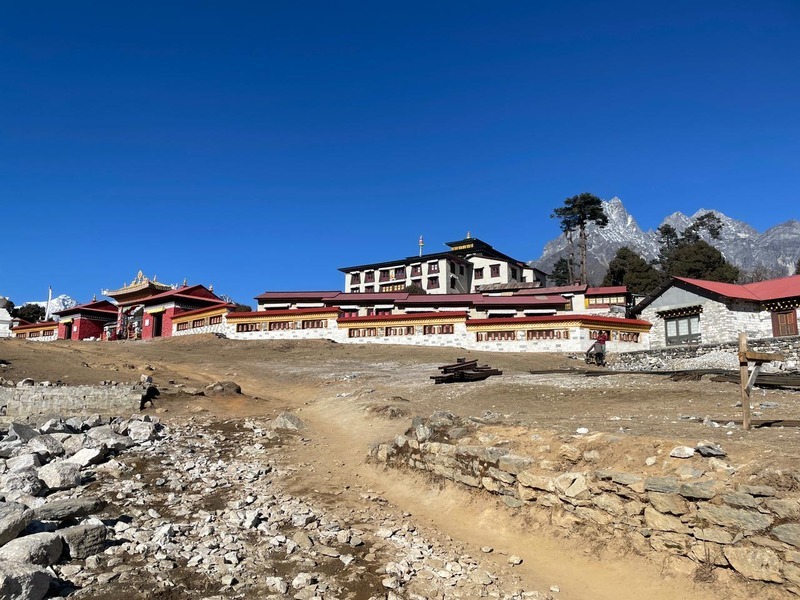
Largest in Khumbu: Nestled amidst the Himalayas, Tengboche Monastery stands as the largest and most significant Tibetan Buddhist monastery in the Khumbu region. Its rich history and cultural significance make it a cherished landmark for both locals and visitors alike.
Stunning Location: Perched majestically atop a ridge at an elevation of 3,867 meters, Tengboche Monastery boasts a breathtaking location blessed with panoramic views of some of the world’s highest peaks, including Everest and Ama Dablam. The tranquil surroundings and awe-inspiring vistas create a serene atmosphere conducive to spiritual reflection and inner peace.
Blessings and Celebrations: Tengboche Monastery is not only a place of worship but also a center for religious ceremonies and celebrations. Visitors have the opportunity to witness monks performing daily rituals, chanting prayers, and engaging in meditation practices. Additionally, the monastery hosts the annual Mani Rimdu festival, a vibrant and colorful event that attracts pilgrims from far and wide. Joining in the festivities of Mani Rimdu offers travelers a unique cultural experience, complete with traditional dances, music, and religious blessings, leaving a lasting impression of the spiritual richness of the Himalayan region.
Dingboche: High-Altitude Beauty
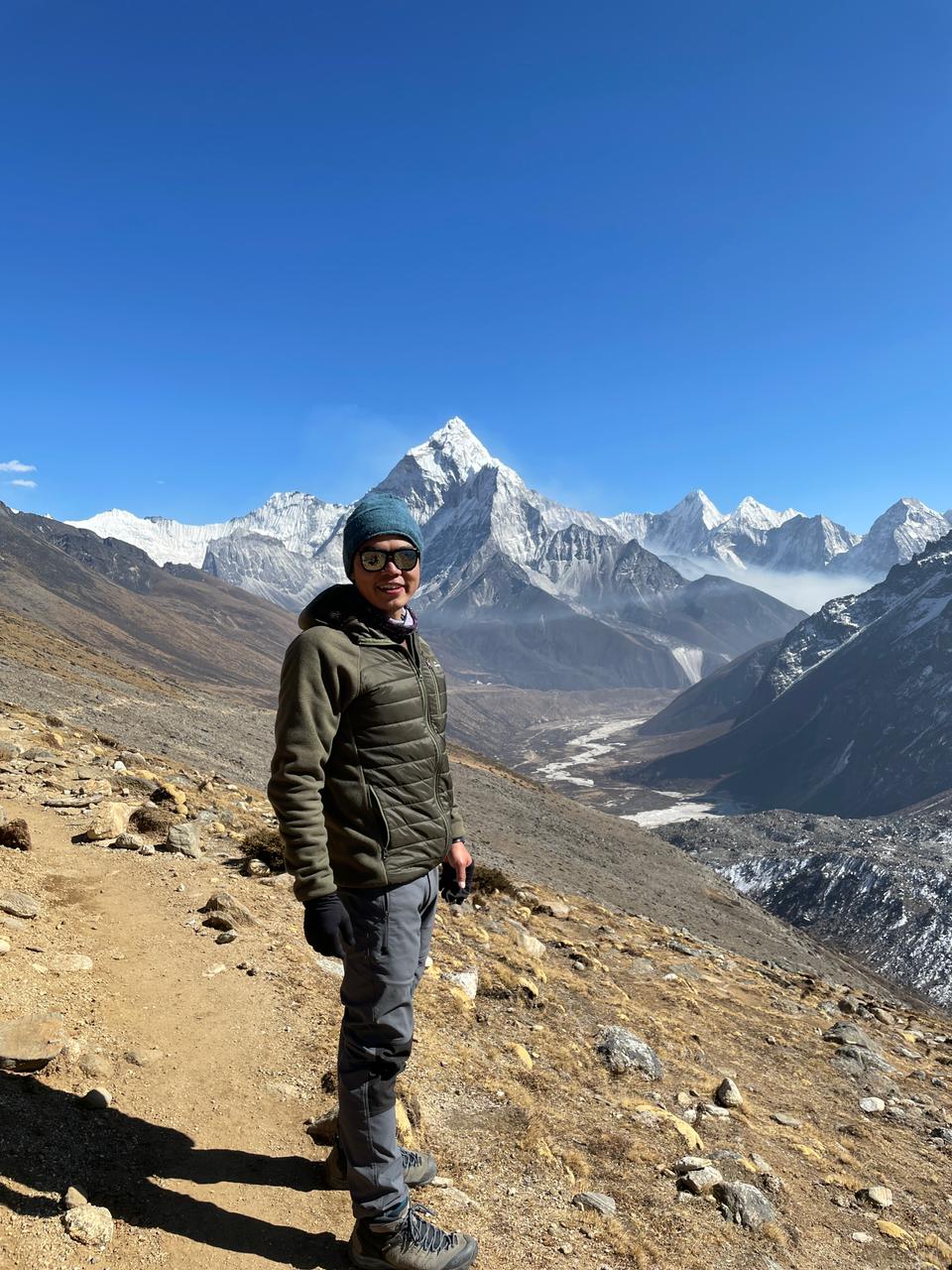
Vast Valley: At an impressive altitude of 4,410 meters, Dingboche sprawls out as a vast high-altitude valley, offering trekkers a common rest stop amidst the rugged terrain of the Khumbu region. This expansive valley provides a serene and spacious setting for travelers to catch their breath and soak in the surrounding natural beauty.
Picturesque Surroundings: Dingboche is surrounded by picturesque scenery that epitomizes the Himalayan landscape. Here, yaks leisurely graze in the verdant meadows, while traditional stone Sherpa houses dot the landscape, exuding a timeless charm. Against this backdrop, the towering peaks of the Himalayas rise majestically, creating a breathtaking panorama that captures the essence of the region’s rugged beauty.
Further Acclimatization: Dingboche serves as another crucial opportunity for trekkers to acclimatize their bodies to the thin air of higher altitudes before embarking on the final ascent towards Everest Base Camp.
Spending time in Dingboche allows travelers to adjust gradually to the altitude, reducing the risk of altitude sickness and ensuring a safer and more enjoyable trekking experience. As trekkers take in the tranquility of Dingboche and prepare for the challenges ahead, they are met with a sense of anticipation and determination for the final push to reach their destination amidst the towering peaks of the Himalayas.
Everest Base Camp: Where Dreams Begin
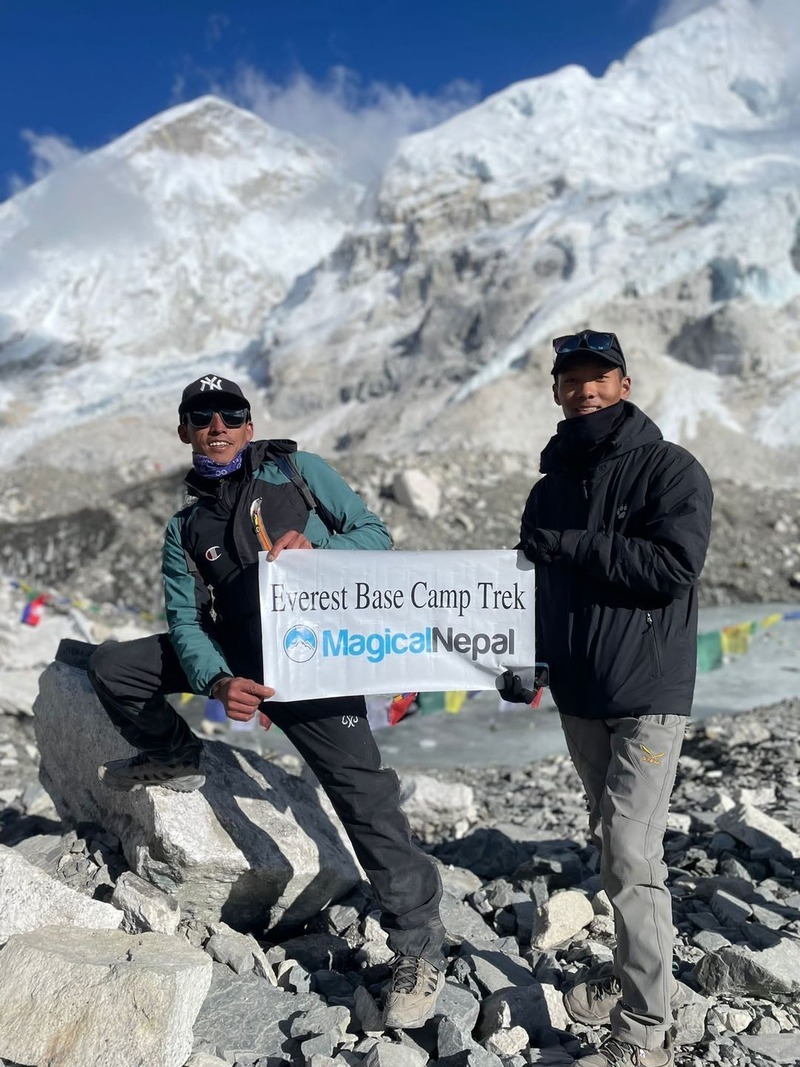
The Goal: For many adventurers, catching a glimpse of Everest Base Camp at 5,364 meters marks the pinnacle of their journey. While the visit may be fleeting during a helicopter tour, the sight of this legendary base camp symbolizes the culmination of a remarkable and unforgettable expedition.
Expedition Hub: During peak climbing season, Everest Base Camp transforms into a bustling tent city adorned with colorful domes, bustling with climbers, and their support crews. The vibrant atmosphere reflects the energy and determination of those embarking on the ultimate mountaineering challenge, adding to the sense of excitement and anticipation in the air.
The Starting Point: Standing at Everest Base Camp, one can’t help but be inspired by the legendary climbs that begin from this spot. As you gaze upon the towering peaks and glaciers that surround you, you feel the magnetic pull of the world’s highest summit, beckoning you to join the ranks of those who have dared to conquer its formidable heights. In this hallowed ground, dreams are born, and adventures of a lifetime are set into motion, making Everest Base Camp a place where dreams truly begin.
Khumbu Glacier and Icefall: Nature’s Power
Dynamic Ice: Prepare to witness the awe-inspiring spectacle of the Khumbu Glacier, a colossal river of ice flowing down from the slopes of Everest. This massive glacier, with its slow and majestic movement, reminds you of the raw power and geological forces at play in the Everest region.
Treacherous Beauty: As you gaze upon the Khumbu Icefall, you’ll be struck by its treacherous beauty. This chaotic landscape of towering ice towers and deep crevasses poses a formidable challenge for climbers attempting to navigate through it on their journey to the summit. Despite its breathtaking allure, the Khumbu Icefall demands the utmost respect and caution from those who dare to traverse its icy terrain.
Appreciation for Forces: Standing amidst the vast expanse of the Khumbu Glacier and witnessing the ever-changing landscape of the Khumbu Icefall, one can’t help but gain a profound appreciation for the immense power and constant movement of this glacial environment. From the slow but relentless flow of the glacier to the dynamic and unpredictable nature of the icefall, the forces of nature are on full display, inspiring a sense of reverence and humility in the face of such natural wonders.
Kala Patthar: The Ultimate Vantage Point
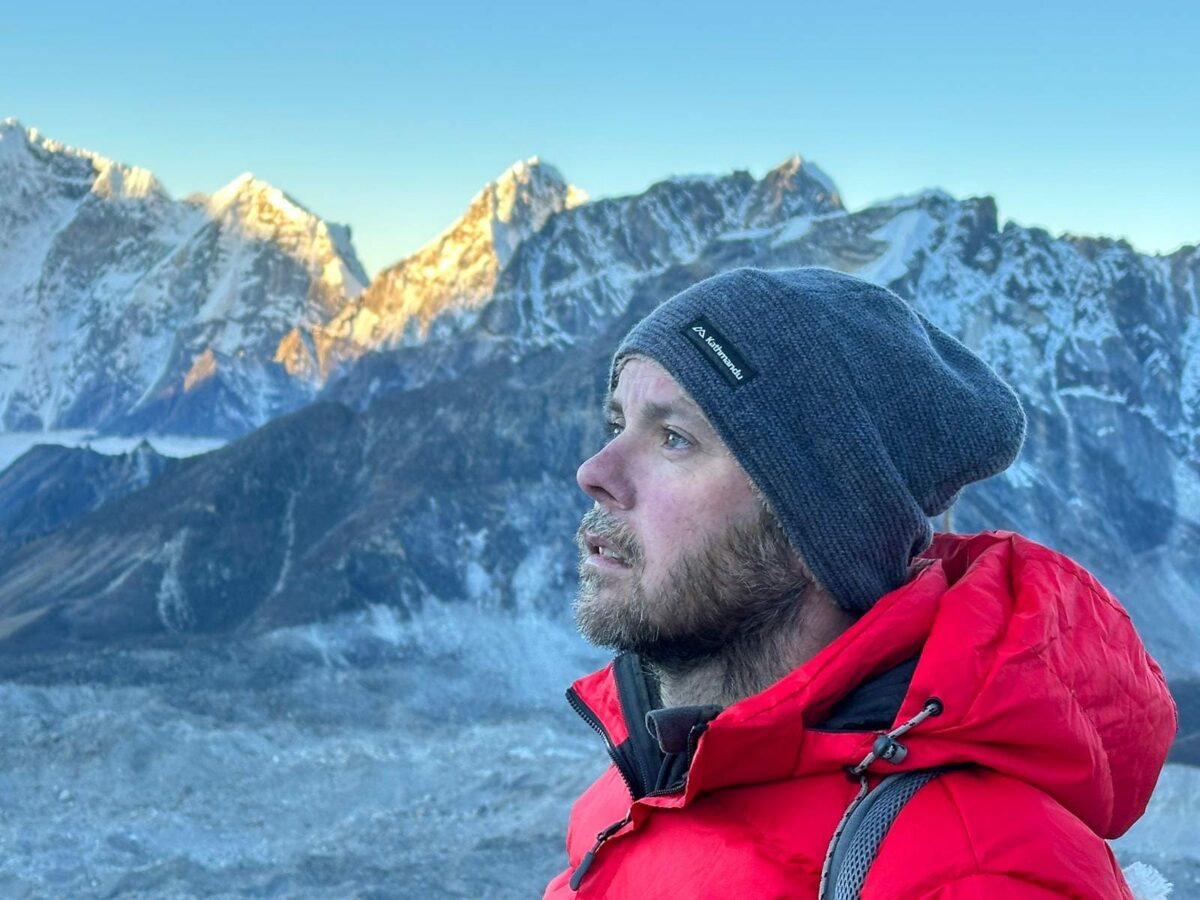
The Pinnacle View: Named for its meaning “black rock,” Kala Patthar stands as a peak at 5,643 meters, easily accessible by a short hike from Gorakshep. Despite its modest elevation compared to Everest, this vantage point offers one of the most breathtaking views in the Khumbu region.
Everest Unveiled: Considered Everest’s premier viewpoint, Kala Patthar offers a perspective even closer than that of Base Camp. From this elevated perch, the full majesty of the pyramid peak of Everest is unveiled, towering above the surrounding landscape. Flanked by the formidable peaks of Nuptse and Lhotse, Everest commands the horizon, leaving visitors in awe of its grandeur and magnificence.
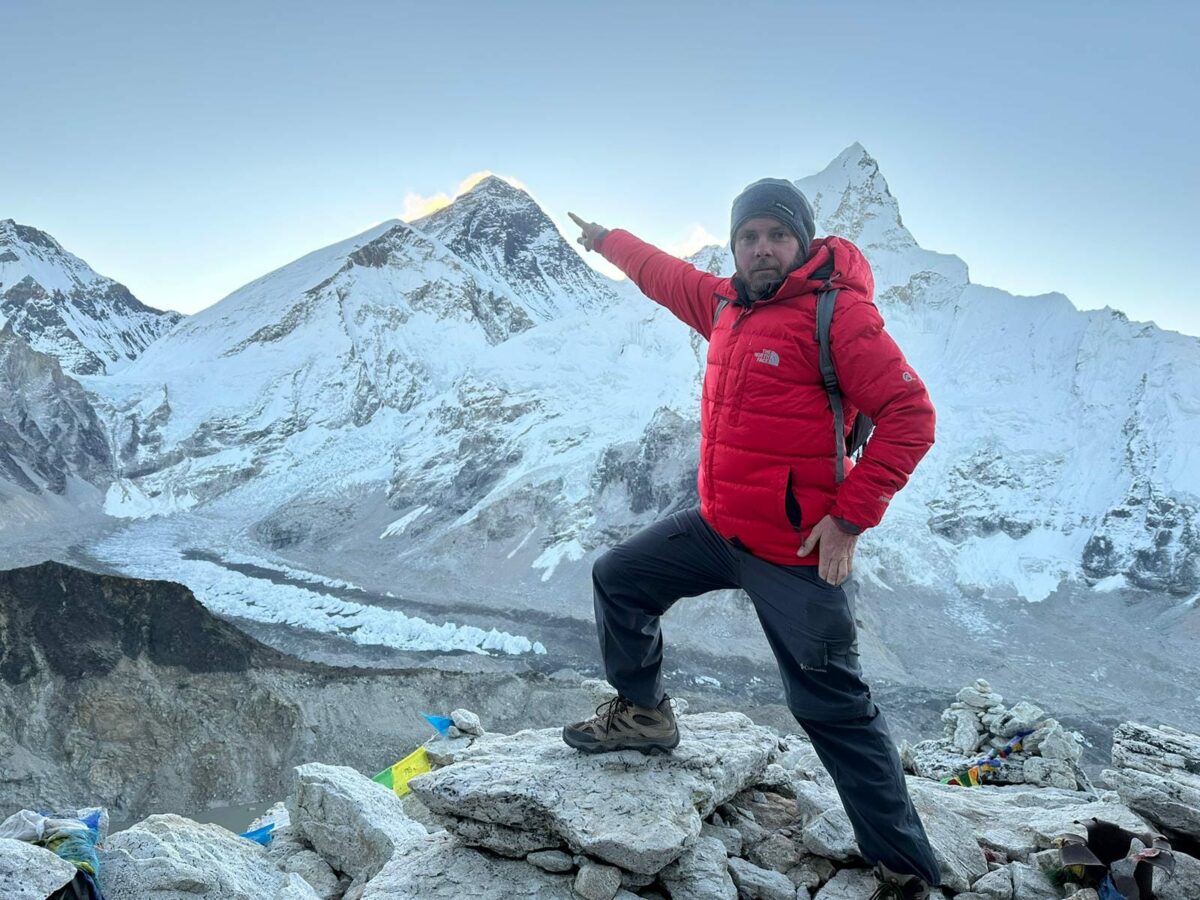
360-Degree Panorama: But Kala Patthar offers more than just a glimpse of Everest. From its summit, one can enjoy a mesmerizing 360-degree panorama of the entire Khumbu region. The view encompasses the iconic Everest, the sprawling Khumbu Icefall, vast glaciers, and a host of other Himalayan giants that dominate the skyline. It’s a spectacle that captures the essence of the Himalayas in all their breathtaking glory, leaving an indelible impression on all who are fortunate enough to behold it.
Lukla: The Iconic Airport in the world
Thrilling Airport: Lukla Airport’s short, sloped runway has earned its reputation as one of the world’s highest and most challenging airports, making it famous (or infamous) among adventurers. Situated amidst the towering peaks of the Himalayas, the approach and landing at Lukla Airport are exhilarating experiences that set the tone for your adventure in the Everest region.
The Beginning & End: Your helicopter adventure in the Everest region begins and ends at Lukla Airport, where you’ll embark on thrilling take-offs and landings amidst the dramatic mountain scenery. Whether you’re starting your journey or returning from an unforgettable aerial excursion, Lukla Airport serves as the gateway to your Everest adventure, with each departure and arrival filled with excitement and anticipation.
Bustling Trailhead: Lukla’s unique mountain town atmosphere is further enhanced by the bustling activity of trekkers embarking on their Himalayan adventures or returning from their journeys. As you observe the comings and goings at Lukla Airport, you’ll witness the vibrant energy of the Everest trekking community, adding to the charm and character of this iconic trailhead town nestled in the heart of the Himalayas.
Related Trip to the Everest Region
Helicopter Tour
20% off
Price Per person
USD $1,500 USD $1,800
- Satisfied Client
- Personalised Guide
- Instant Response
Get Instant Response:
+977-9851329446 (Whatsapp)
